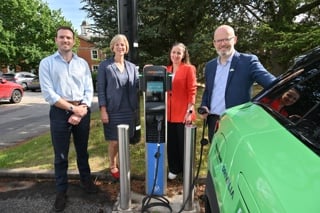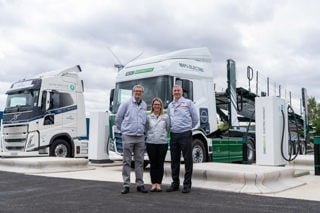The number of UK electric vehicle (EV) charging hubs, which have more than six rapid or ultra rapid devices, more than doubled year-on-year, according to new figures from Zapmap.
At the end of December 2022, there were 108 charging hubs, but by the end of 2023 this had risen to 264 – an increase of 145%.
These charging hubs are opening in a variety of locations, typically near strategic road networks, but the Zapmap data suggests that only a fifth (20%) are located at motorway services.
Every motorway service station in England was supposed to have at least six rapid or ultra-rapid chargers by the end of 2023.
However, recent data from the RAC suggested that just two out of five (40%) of services have the requisite chargers in place.
Charging hubs, says Zapmap, can be found in a variety of locations from retail parks, car parks, fuel stations to dedicated charging areas which provide amenities for EV drivers.
Record growth in the number of ultra-rapid chargers and high-power charging hubs opening across the country to support EV drivers on longer journeys was the defining characteristic of last year.
Indeed, the new 2023 charging statistics show year-on-year growth of 45% in the total number of net new public chargers installed across the UK.
The figure is up from 31% for the years 2021 to 2022.
In October, the UK passed the significant milestone of 50,000 public charging points, having only surpassed the 40,000 mark in February 2023.
Furthermore, 2023 saw the rate of net new chargers increase to almost 1,400 devices every month – up from 730 net new devices each month in 2022. This represents growth of 89% in the pace of monthly charge points installations.
The number of high-powered chargers grew by 52% in 2023, to a total of almost 10,500 devices across more than 5,000 locations at the end of December.
Most of the growth was from ultra-rapid chargers providing 100kW or more of power.
At the end of 2020, the 788 devices in the UK of 100kW or more accounted for 20% of the country’s high-powered chargers.
By the end of December 2023, there were almost 4,870 of these ultra-rapid chargers, comprising a significant 46% of high-powered devices across the country.
Ian Johnston, chair of ChargeUK, said: “These numbers can give drivers further confidence. Our members are putting charge points in the ground at record pace and will spend £6 billion before 2030 on ensuring the UK has the right charging solutions in the right place.
“But we intend to go even further and faster this year to make the UK the best place in the world to drive and charge an EV.”
Zapmap’s latest figures also illustrate encouraging developments in the UK’s regional distribution of high-powered charging devices.
Since 2022, Greater London, the south-east and the south-west have joined Scotland in having more than 1,000 rapid/ultra rapid chargers available, and nearly all geographical areas of the UK displayed good growth, notably Northern Ireland, albeit from a low base.
At the other end of the charging spectrum, low powered chargers to support those without charging points at home has also grown - there are 72% more on-street chargers than there were this time last year, although the rollout is regionally patchy and largely dependent on the engagement at a local authority level.
However, Zapmap says that there was good progress in the rollout of the Governments £450 million Local Electric Vehicle Infrastructure (LEVI) scheme to support local authorities, and it is expected that 2024 will see further developments in this area.
Melanie Shufflebotham, co-founder and chief operating officer at Zapmap, said: “Overall 2023 was a very good year for EV charging with the rate of installation showing record growth, particularly for the higher-powered chargers to support EV drivers on longer journeys.
“Zapmap’s focus continues to be on providing EV drivers with the information they need to find reliable, available charging when they are out and about.
“Whilst less than 3% of EV drivers would go back to petrol/diesel, we know that EV drivers want more chargers and a better charger experience.
“As we move into 2024 we look forward to continued progress in both these areas as more and more drivers make the positive move to driving electric.”
























Login to comment
Comments
No comments have been made yet.